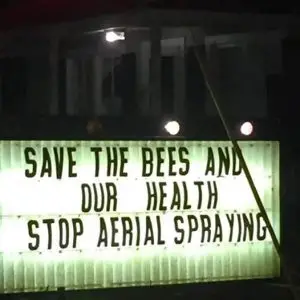On August 29 Flowertown Bee Farm owners in Summerville, South Carolina woke up to a cruel, unwanted surprise — 2.5 million dead bees from 46 hives. These were the rescue hives that the owner, Nita Mae, acquired to help the dying bee population.
This time the bees were hit by what might one of the strongest and most dangerous chemicals being sprayed in our environment today: Naled, which is banned in the European Union, but is still used in the U.S. It is a highly toxic organophosphate, and it was sprayed from planes in order to eliminate mosquitoes that may have been carrying the Zika virus, officials said.
The next day the local government posted a notice on their site confirming that aerial spraying against mosquitoes took place that Sunday, August 28. They sent two announcements about it on August 26 and 27 to the mainstream media channels, and there was a Facebook post on Saturday. The local officials considered this to be a fair warning.
But according to a Change.org petition, the population was not told which chemical was going to be used or that it was going to be sprayed by planes (the local government site only mentioned spraying by trucks).
Many did not hear about any type of spraying being done until it was too late.
“Had I known, I would have been camping on the steps doing whatever I had to do screaming, ‘No you can’t do this,’” Flowerton Bee Farm co-owner Juanita Stanley told WCSC-TV.
Watch the devastating effect Naled had on the Flowertown Bee Farm below. The beekeepers say they did not know the spraying was taking place, and even let the kids play outside that day.
What is Naled?
“I was angry that day,” admits one beekeeper in a TV interview. “I couldn’t wrap my head around that we spray poison from the sky.”
Naled is an insecticide, which has been used since 1959 in the U.S., according to the Environmental Protection Agency (EPA). It previously has been used in 2004 in Florida after a hurricane emergency, in 2005 in Lousiana, Mississippi and Texas after Hurricane Katrina, and in 1987 in Puerto Rico when attempting to control dengue.
Watch a plane similar to North Carolina’s spraying chemicals in Miami recently:
Is It Naled — Or a Cocktail of Chemicals Called DIBROM?
The most common Naled product used in aerial spraying is DIBROM, manufactured by AMVAC Chemical. Besides Naled, the product contains other chemicals such as DDVP (Dichlorvos), which has been classified as “possibly carcinogenic to humans.”
As early as 1990s, Japanese researchers raised red flags over the government’s underplaying of the risks of this chemical. One study found significantly high amounts of cancer in rats when exposed to Dichlorvos.
“Dichlorvos caused or was associated with neoplastic responses in rats (pancreas, hematopoietic system, and possibly the mammary gland) and in mice (forestomach),” they concluded.
Why Was Naled used in South Carolina?
The government decided to spray Naled in order to kill Zika-carrying mosquitos, yet there is no proof of their existence in South Carolina at this time. The state has seen four Zika cases, but all of them were travel-related, and none were from a local mosquito bite, reported The Washington Post.
Bee Impact was Not Anticipated by the Government
“It was just devastation; there were piles of dead bees,” Stanley said.
While there has already been a 40 percent of honeybee population decline in one year alone in the U.S. already (between April 2014 and April 2015), millions of bees dying overnight is an still an unusual and senseless loss.
But the local government of Dorchester County, South Carolina stated on their site that they did not “anticipate significant exposure to bees.” When asked about the harm to the honey bee population, their answer skirted the issue, saying only that the chemical “dissipates rapidly and does not persist in the environment,” therefore posing risks mainly to aquatic life. However, it had been recommended that the chemical application take place between dusk and dawn as a precautionary measure, as the bees are not out foraging during these times.
When was Naled sprayed? According to another government site: “Spraying runs from 9 p.m. – 5 a.m., Monday thru Friday.”
Yet this was not enough to protect the bees. Some beekeepers say that because of the hot weather, the bees left their homes at night to cool down.
After the plane went over Stanley’s property three times, the buzzing instantly stopped. She described it as if suddenly being in a morgue, reported The Washington Post.
The farm look liked “it’s been nuked,” Stanley said.
Other sources point to the government’s poor knowledge of the risks. Cornell University’s database calls Naled “highly toxic to bees.” The university’s report also raises more concerns for Naled impact on human health.
If It Kills Bees, What Health Impact Does It Have on Us?
“If everyone just goes to the EPA website and starts reading the precautions, you’ll be beside yourself,” says one beekeeper.
Dorchester County government admits that a person will have detectable amounts of the chemical Naled when exposed to it, but states that no test can show whether or not there will be health effects.
And yet, they admit that “it is a good idea to reduce unnecessary exposure to pesticides,” that people sensitive to chemicals should protect themselves, and that is is best to stay indoors with windows closed, and if exposed to the chemical, rinse the skin and eyes, and call the doctor if a negative reaction occurs.
Cornell University delivers a different picture of Naled. According to their database, the chemical is moderately to highly toxic by inhalation, dermal absorption, and ingestion. Exposure to Naled is especially risky for people with existing respiratory and liver issues. Inhalation of Naled can lead to coughing, bloody or runny nose, difficulty breathing, and chest discomfort. Skin contact with Naled can cause to involuntary muscle contractions and sweating.
Any type of exposure can lead to “pallor, nausea, vomiting, diarrhea, abdominal cramps, headache, dizziness, eye pain, blurred vision, constriction or dilation of the eye pupils, tears, salivation, sweating, and confusion.”
A severe poisoning can lead to problems with “the central nervous system, producing incoordination, slurred speech, loss of reflexes, weakness, fatigue, involuntary muscle contractions, twitching, tremors of the tongue or eyelids, and eventually paralysis of the body extremities and the respiratory muscles. In severe cases there may also be involuntary defecation or urination, psychosis, irregular heart beats, unconsciousness, convulsions and coma. Death may be caused by respiratory failure or cardiac arrest.”
Repeated exposure to the chemical can result in the same symptoms but after a longer period of time.
While the amount of Naled used in a few aerial sprays claims to follow the EPA’s exposure limit, is it possible to calculate the health effects when combined with repeated exposure to all of the other toxins in our environment?
What Is Next?
The local population is concerned that this type of spraying can happen in the future.
A Change.org petition titled “Save Humanity & Save The Bees,” points out the following problems that need to be addressed.
- In the future, people need to be notified more than a day in a advance that the spraying will take place.
- People living in the affected areas need to receive full information about which chemical is going to be used, whether it will be sprayed by planes or trucks, and a full list of potential side effects (health and environmental) needs to be distributed.
- These health and environmental concerns need to be addressed, especially when it comes to kids, pregnant women, and people with pre-existing health issues.
Thanks for installing the Bottom of every post plugin by Corey Salzano. Contact me if you need custom WordPress plugins or website design.







